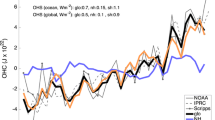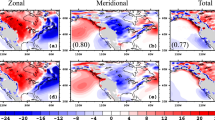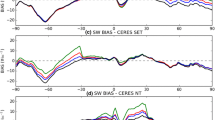Abstract
Atmospheric heat transport (AHT) moderates spatial gradients in surface temperature, and its efficiency (hereinafter referred to as diffusivity) shapes the distribution of moist static energy and the hydrological cycle. Using a linear downgradient rule for AHT, we diagnose zonal-mean diffusivity using observational and model data. We find it varies two- to threefold with season and latitude, but is nearly invariant across different climate states. We then employ a moist energy balance model (MEBM) to explore the impacts of changing the magnitude and spatial pattern of diffusivity on the climatology and climate response to forcing. Spatial anomalies in diffusivity in the extra-tropics have a larger impact on temperature and hydrology than diffusivity anomalies in the tropics. We demonstrate that compensating dynamical adjustments in the MEBM act to mute the impact of changing diffusivity patterns on the resulting climate. We isolate the impacts of spatial patterns of forcing, ocean heat uptake, radiative feedbacks, and diffusivity on the spatial pattern of climate change; and find that the pattern of climate change is least sensitive to the detailed pattern of diffusivity. Overall, these results suggest that although diffusivity is far from spatially invariant, understanding the climatology and spatial patterns of climate change does not depend on a detailed characterization of the spatial pattern of diffusivity.





Similar content being viewed by others
Data availability
The ERA5 data used in this study are available at https://cds.climate.copernicus.eu/cdsapp#!/dataset/reanalysis-era5-pressure-levels. The CMIP5 data used in this study are available at https://esgf-node.llnl.gov/search/cmip5/.
References
Armour KC, Siler N, Donohoe A, Roe GH (2019) Meridional atmospheric heat transport constrained by energetics and mediated by large-scale diffusion. J Clim 32(12):3655–3680. https://doi.org/10.1175/JCLI-D-18-0563.1
Barry L, Craig GC, Thuburn J (2002) Poleward heat transport by the atmospheric heat engine. Nature 415(6873):774–777. https://doi.org/10.1038/415774a
Bonan DB, Armour KC, Roe GH, Siler N, Feldl N (2018) Sources of uncertainty in the meridional pattern of climate change. Geophys Res Lett 45(17):9131–9140. https://doi.org/10.1029/2018GL079429
Bonan DB, Siler N, Roe GH, Armour KC (2023) Energetic constraints on the pattern of changes to the hydrological cycle under global warming. J Clim 36(10):3499–3522. https://doi.org/10.1175/JCLI-D-22-0337.1
Braconnot et al, Evaluation of climate models using palaeoclimatic data (2012) Nat Clim Change 2, 417–424. https://doi.org/10.1038/nclimate1456
Chang CY, Held IM (2022) A scaling theory for the diffusivity of poleward eddy heat transport based on Rhines scaling and the global entropy budget. J Atmos Sci 79(6):1743–1758. https://doi.org/10.1175/JAS-D-21-0242.1
Cox T, Donohoe A, Roe GH, Armour KC, Frierson DM (2022) Near invariance of poleward atmospheric heat transport in response to midlatitude orography. J Clim 35(13):4099–4113. https://doi.org/10.1175/JCLI-D-21-0888.1
Donohoe A, Armour KC, Roe GH, Battisti DS, Hahn L (2020) The partitioning of meridional heat transport from the Last Glacial Maximum to CO2 quadrupling in coupled climate models. J Clim 33(10):4141–4165. https://doi.org/10.1175/JCLI-D-19-0797.1
Feldl N, Roe GH (2013) The nonlinear and nonlocal nature of climate feedbacks. J Clim 26(21):8289–8304. https://doi.org/10.1175/JCLI-D-12-00631.1
Flannery BP (1984) Energy balance models incorporating transport of thermal and latent energy. J Atmosp Sci 41(3):414–421. https://doi.org/10.1175/1520-0469(1984)041%3c0414:EBMITO%3e2.0.CO;2
Held IM (2001) The partitioning of the poleward energy transport between the tropical ocean and atmosphere. J Atmos Sci 58(8):943–948. https://doi.org/10.1175/1520-0469(2001)058%3c0943:TPOTPE%3e2.0.CO;2
Hersbach, H, Bell, B, Berrisford, P, Hirahara, S, Horányi, A, Muñoz‐Sabater, J., ... Thépaut, JN (2020) The ERA5 global reanalysis. Q J R Meteorol Soc 146(730): 1999–2049. https://doi.org/10.1002/qj.3803
Hwang, YT, Frierson, DM (2010) Increasing atmospheric poleward energy transport with global warming. Geophys Res Lett 37(24). https://doi.org/10.1029/2010GL045440
Hwang, YT, Frierson, DM, Kay, JE (2011) Coupling between Arctic feedbacks and changes in poleward energy transport. Geophys Res Lett 38(17). https://doi.org/10.1029/2011GL048546
Lapeyre G, Held IM (2004) The role of moisture in the dynamics and energetics of turbulent baroclinic eddies. J Atmos Sci 61(14):1693–1710. https://doi.org/10.1175/1520-0469(2004)061%3c1693:TROMIT%3e2.0.CO;2
Lu J, Zhou W, Kong H, Leung LR, Harrop B, Song F (2022) On the diffusivity of moist static energy and implications for the polar amplification response to climate warming. J Clim 35(21):7127–7146. https://doi.org/10.1175/JCLI-D-21-0721.1
Merlis TM, Henry M (2018) Simple estimates of polar amplification in moist diffusive energy balance models. J Clim 31(15):5811–5824. https://doi.org/10.1175/JCLI-D-17-0578.1
Merlis TM, Feldl N, Caballero R (2022) Changes in poleward atmospheric energy transport over a wide range of climates: energetic and diffusive perspectives and a priori theories. J Clim 35(20):6533–6548. https://doi.org/10.1175/JCLI-D-21-0682.1
Mooring, TA, Shaw, TA (2020) Atmospheric diffusivity: a new energetic framework for understanding the midlatitude circulation response to climate change. Journal of Geophysical Research: Atmospheres, 125(1). https://doi.org/10.1029/2019JD031206
North GR (1975) Theory of energy-balance climate models. J Atmosp Sci 32(11):2033–2043. https://doi.org/10.1175/1520-0469(1975)032%3c2033:TOEBCM%3e2.0.CO;2
Pierrehumbert RT (2010) Principles of planetary climate. Cambridge University Press, Cambridge, UK
Rencurrel, MC, & Rose, BE (2018). Exploring the climatic response to wide variations in ocean heat transport on an aquaplanet. J Clim 31(16): 6299–6318. /https://doi.org/10.1175/JCLI-D-17-0856.1
Roe GH, Feldl N, Armour KC, Hwang YT, Frierson DM (2015) The remote impacts of climate feedbacks on regional climate predictability. Nat Geosci 8(2):135–139. https://doi.org/10.1038/ngeo2346
Rose BE, Armour KC, Battisti DS, Feldl N, Koll DD (2014) The dependence of transient climate sensitivity and radiative feedbacks on the spatial pattern of ocean heat uptake. Geophys Res Lett 41(3):1071–1078. https://doi.org/10.1002/2013GL058955
Shaw TA, Voigt A (2016) What can moist thermodynamics tell us about circulation shifts in response to uniform warming? Geophys Res Lett 43(9):4566–4575. https://doi.org/10.1002/2016GL068712
Siler N, Roe GH, Armour KC (2018) Insights into the zonal-mean response of the hydrologic cycle to global warming from a diffusive energy balance model. J Clim 31(18):7481–7493. https://doi.org/10.1175/JCLI-D-18-0081.1
Taylor K, Stouffer R, Meehl G (2012) An overview of CMIP5 and the experiment design. Bull Am Meteorol Soc 93:485–498. https://doi.org/10.1175/BAMS-D-11-00094.1
Trenberth KE, Caron JM (2001) Estimates of meridional atmosphere and ocean heat transports. J Clim 14(16):3433–3443. https://doi.org/10.1175/1520-0442(2001)014%3c3433:EOMAAO%3e2.0.CO;2
Acknowledgements
We thank the editor Jian Lu, and three reviewers.
Funding
Q.G., A.D., K.C.A., and G.H.R were supported by National Science Foundation Award CLD2019647.
Author information
Authors and Affiliations
Contributions
All authors contributed to the design, analyses, and writing of the manuscript.
Corresponding author
Ethics declarations
Conflict of interest
The authors have no relevant financial or non-financial interests to disclose.
Additional information
Publisher's Note
Springer Nature remains neutral with regard to jurisdictional claims in published maps and institutional affiliations.
Appendix A
Appendix A
See Appendix Table 1.
We follow Siler et al. (2018) in implementing a hydrologic cycle within the MEBM. We specify a Gaussian weighting function, \(w\left(x\right)\), to separate the total heat transport into eddy (\({F}_{\mathrm{eddy}}\left(x\right)\)) and Hadley Cell (\({F}_{\mathrm{HC}}\left(x\right)\)) components:
We set \(w\left(x\right)=\mathrm{exp}[-{\left(x/{\sigma }_{x}\right)}^{2} ]\), where \({\sigma }_{x}=\mathrm{sin}\left(15^\circ \right)\approx 0.26\), so that \({F}_{\mathrm{eddy}}\left(x\right)\) accounts for nearly all energy transport in mid-to-high latitudes, while \({F}_{\mathrm{HC}}\left(x\right)\) accounts for most energy transport in low latitudes within 15°. \({F}_{\mathrm{HC}}\left(x\right)\) is quantified by
where \(\psi \left(x\right)\) is the Hadley Cell mass transport (with southward transport in the lower branch equal to northward transport in the upper branch,) and \(g\left(x\right)\) is the gross moist stability of the atmosphere, defined as the difference between MSE in the upper and lower branches at each latitude. Following Held (2001), we assume that MSE is uniform ( \(\equiv {h}_{u}\)), throughout the upper branch of the Hadley cell such that variations in \(g(x)\) are primarily caused by meridional variations in near-surface MSE: \(g\left(x\right)={h}_{u}-h\left(x\right)\), where we set \({h}_{u}=1.07 h(x=0)\), or 7% above the near-surface MSE at the equator, which is a reasonable approximation to the observed profile (Siler et al. 2018). We can get \(g\left(x\right)\) from the MEBM output fields, and hence solve for \(\psi \left(x\right)\) from (A2) and (A3). Finally, assuming the upper branch of the Hadley Cell is dry, moist heat transport (\({F}_{\mathrm{HC},q}\)) is confined in the lower branch, implying that
Finally, we derive \(E-P\) by taking the divergence of \({{F}_{eddy, q}+F}_{\mathrm{HC},q}\).
Rights and permissions
Springer Nature or its licensor (e.g. a society or other partner) holds exclusive rights to this article under a publishing agreement with the author(s) or other rightsholder(s); author self-archiving of the accepted manuscript version of this article is solely governed by the terms of such publishing agreement and applicable law.
About this article
Cite this article
Ge, Q., Zheng, Z., Kang, L. et al. The sensitivity of climate and climate change to the efficiency of atmospheric heat transport. Clim Dyn 62, 2057–2067 (2024). https://doi.org/10.1007/s00382-023-07010-3
Received:
Accepted:
Published:
Issue Date:
DOI: https://doi.org/10.1007/s00382-023-07010-3




